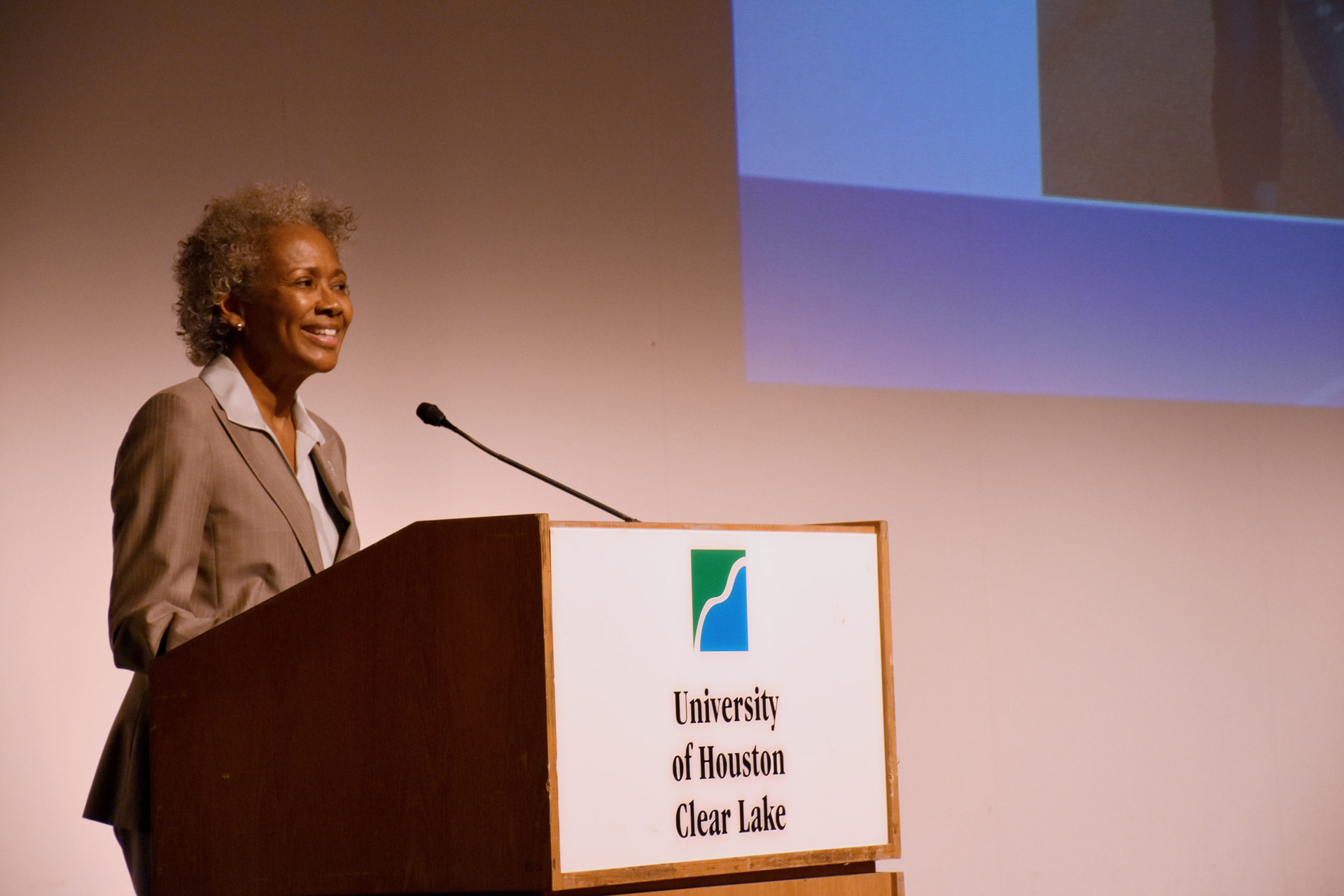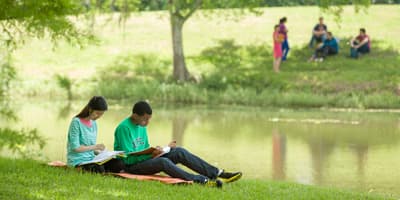- Future Students
- How to Apply
- Visit UHCL
- Admitted Students
- Tuition, Costs and Aid
- Degrees and Programs
- Contact Admissions
- More Information
- Current Students
- Class Schedule
- Academic Calendar
- Advising
- Events
- Library
- Academic Resources and Support
- Student Services and Resources
- More Information
- Alumni
- Lifetime Membership
- Alumni Events
- Update Your information
- Awards and Recognitions
- Give to UHCL
- More Information
UHCL’s president’s first 100 days: Nod to the past, focus on future
November 30, 2017 | Jim Townsend

In charting a course for the future, you must be mindful of the past, to paraphrase Ira. K. Blake during a special presentation honoring her first 100 days as president of University of Houston-Clear Lake.
Blake illustrated her point with the Ghanaian proverb of Sankofa, traditionally symbolized by a bird with its head turned backward carrying a precious egg on its back.
“The proverb translates, ‘It is not wrong to go back for that which you have forgotten,’” Blake said. “By extension, Sankofa tells us that out of strong history comes a stronger future.”
She used the allegory to emphasize UH-Clear Lake’s promise as a high-impact university for the 21st century.
“That promise will be compromised if we do not define what it means for us: what it takes for us to accomplish it; how to determine that we are actually making our desired progress; and what, where, when and how to adjust is necessary in our joint pursuit of that promise.”
With that in mind, Blake announced that in spring 2018 the university will embark on developing its next strategic plan – to pick out the path for growth between the rocks and ravines of upcoming legislative budget cycles.
Blake said the planning process will include “full representation of our campus membership as well as the inclusion of some of our alumni and key invested community partners.”
The last strategic plan for UHCL, developed for 2010-15, saw the university’s expansion to a full four-year institution, the addition of several graduate and undergraduate programs, the introduction of doctoral programs and the expansion of online degrees. It culminated in funding for the university’s physical expansion as well – including campuses in Pearland and the Texas Medical Center. New buildings are now under construction on the Clear Lake campus and in Pearland.
Learnings and impressions
Commenting on what she has learned in her first 100 days, the transplanted Pennsylvanian talked of her experience with Harvey, her first coastal hurricane. Just 25 days into her tenure, her first major decision was to close the campus before the fall semester began. After Harvey, faculty, administrators, staff and students worked to bring relief to the disaster-stricken community.
“The hidden lining of Harvey was not silver but one of UH-Clear Lake Kevlar,” she said. “Working with UH-Clear Lake leaders on the emergency management team, I learned that we are a community of care, commitment and cooperation.
“But more so, we are also tough. There is a saying sometimes when things are falling apart they may be actually falling into place. Our response to Harvey taught me that when we move in the same direction for a common purpose, we are unstoppable. Unbreakable. Triumphant.”
Pursuit of educational excellence
She acknowledged UHCL’s roots, explaining UHCL’s creation in the early ’70s to provide advance studies to NASA Johnson Space Center administrators, engineers, scientists and astronauts.
“Some of the most persistent, intelligent, creative, imaginative, innovative people on the face of the Earth – who would not settle for poor instruction, incomplete knowledge, limited expertise, bridled curiosity and constrained possibilities – completed degrees at UH-Clear Lake,” she said.
“The lesson is that our faculty are brilliant teachers. They are active scholars who do not simply regurgitate past knowledge and instruction, but design academic programs and learning opportunities which use past knowledge as a fulcrum for better understanding… to stimulate meaningful problem-solving…. to unleash imagination… to spur invention…and not so simply… to change our world for the better.”
Importance of peer learning
“I arrive sometimes very early to UH-Clear Lake, and I am amazed to see students already here,” she said.
“Some of them studying together, others engaged in conversation. We need to explore how we can increase more formal, substantive peer learning experiences, for example, through group assignments, focused discussion, forensic competitions, service learning projects, student abroad and away, interdisciplinary student research and the like.”
Career exploration and development
Blake acknowledged that career exploration and development are an important and essential complements to academic teaching.
“UH-Clear Lake’s history indicates that recognition of and respect for the connectedness between careers in the real-world and academic study are part of our educational fabric,” she said.
She emphasized the importance of experiential learning opportunities for students of all levels.
“Intuitively, we want students to explore their dispositional preferences, skills strengths and weaknesses, global career interests, taking at least one career road trip in their first year. In their second year, I can imagine students participating in some job-shadowing or a well-structured group project for a not-for-profit or small business.
“And in their third or fourth year, students would take on an internship, study abroad or away in their major or career interest, work on a community research project or develop a service learning project that enables them to use knowledge and skills from their major,” she said.
“You might ask how would we ever do this? I would answer through arrangements with businesses, organizations, and agencies in our service region and around the world…but especially through our network of 60 thousand-plus alumni.”
Student-centered
‘It is important to know who we serve – not only the number of students, but their levels, and demographically who they are,” Blake said.
“If we intend to continue delivering the highest quality educational experiences to the students we admit, then we need to understand – at a minimum – who they are, what strengths and weaknesses they bring to us in terms of our educational goals for them, and what changes their interests, both in terms of major and career.”
She quoted Alexander Den Heijer, a Dutch motivational speaker. “When a flower doesn’t bloom, you fix the environment in which it grows, not the flower.”
Just as Blake opened with her thanks to those in attendance, she closed with thanks while presenting a photo slide of herself with students.
“The slide represents what I have already come to love about UH-Clear Lake – our students,” she said.






